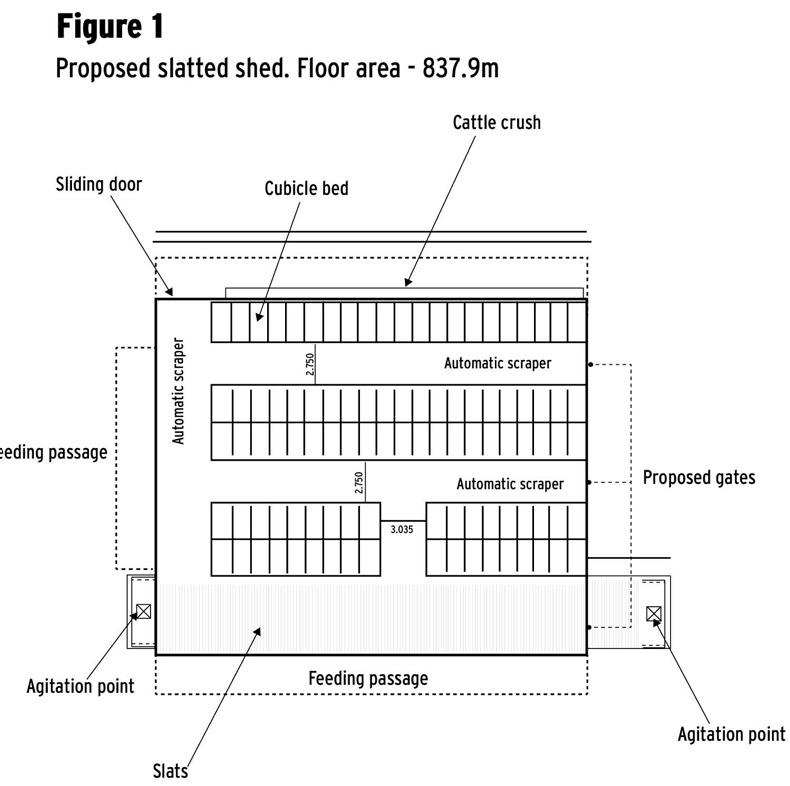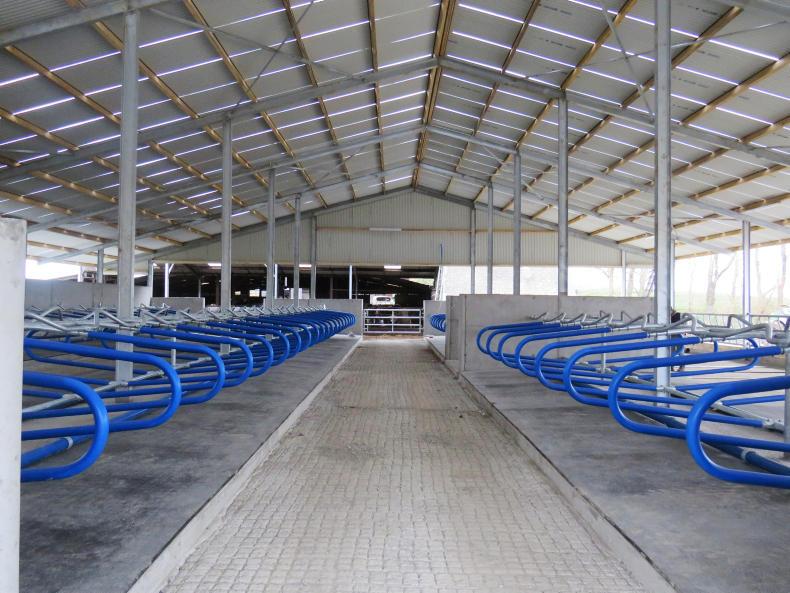Last week, the finishing touches were carried out on Thomas and Donal Breen’s new 99-space cubicle shed in Cooraclare, Co Clare. The father and son team milk 120 spring-calving cows, with plans to grow the herd to 140. However, in recent years they have been under pressure trying to manage some dry cows housed in sheds on outfarms.
The Breens’ cows are coming home.

Thomas and Imy Breen pictured with their son Donal and grandchildren Fiadh and Nathan in their brand new cubicle shed in Cooraclare, Co Clare.
“We really needed all the cows on the home farm. It was getting far too difficult to manage everything when cows were in different places, especially during calving,” Thomas explained. The Breens decided to build a new cubicle shed to increase the accommodation available at home, so that all the cows could be wintered there. Donal planned the new shed so it would fit in with the existing buildings. In time, a new calving area will be set up where an old cubicle area once was. This will be easily accessible from the new cubicle shed, with the main objective being to take as much labour out of the calving season as possible.
The shed cost €160,000 in total, excluding VAT. Some landscaping and extended concrete yards will finish off the job nicely. They plan on doing this work in more suitable weather during the summer months. The Breens are very happy with how the new building turned out and are keen to try it out.
The shed
The new shed fits in nicely with the existing buildings and is strategically situated beside the silage slab. Local farm buildings contractor Declan Fennell did all the building work, including digging, concrete work, shed erection and cubicle/feed barrier kit out. There are two double rows of cubicles and a single row at one end. Feeding will be carried out along one side and a gable end. The majority of silage will be covered with a roof overhang and a canopy. There is a crush along the other side of the shed and this is also covered with an overhang.

Grip
One of the main prerequisites for the floor of the new cubicle shed was that it must have good grip to prevent cows slipping.
“In the recent past, we had the odd issue with a cow doing the splits in the older sheds, so we didn’t want to have similar problems in the new building,” Donal explained. Declan has a specially-designed tamper he uses in cow passages to leave a grip finish to prevent such slips. This finish turned out well, in that it is flat on top, which means the cow’s full hoof is being supported when she walks.
Most building contractors have a method of creating a grip finish in concrete cow passages, be it a tamper, brush or imprint roller. Getting this finish right is important, because it can be a costly exercise to do the job after the concrete has set. Very deep crevices and a honeycomb surface like cobbles may create good grip, but could be very uncomfortable for cows walking.
A balance has to be struck between grip and cow comfort. If you are planning a cubicle shed or similar concrete floors where cows will be walking, ask your building contractor what type of finish they are planning to put in.
It might be worthwhile double checking this finish on other farms where the contractor did similar work, just for peace of mind. Automatic scraper companies might suggest suitable finishes that work for their products also.

Slurry tank
A large slurry tank was built to one side of the cubicle shed. As shown in Figure 1, slurry will be scraped using automatic slurry scrappers from each cow passage and then another scraper will move this slurry to the slatted tank. Declan Carey is in the process of installing the Alfco hydraulic scrapers. The tank is 2.7m (9ft) deep, 36.5m (120ft) long and is topped off with 14ft6in slats. Declan manufactured and placed these slats.
This leaves 383.25m3 useable volume for slurry storage. The Department of Agriculture reference cost for a tank of this size is €32,744, excluding VAT. The crossover point is 3m wide and has a fixed Condon drinker.

Cubicles
The Breens decided to go the extra mile when choosing the type of cubicle beds to use in the new shed. Past experiences played an important roll in their decision making.
“In the old cubicle shed, the odd cow could injure herself in the cubicles, so we wanted to avoid the issue in the new shed,” said Thomas. They opted for a hybrid flex cubicle, manufactured by Condon Engineering.
After seeing the product at the Ploughing, the Breens felt it would be ideal for their new cow accommodation. According to Condon Engineering, the hybrid flex cubicle combines the flexibility of plastic and the stability of the steel structure. In the steel section, there is a zigzag headrail which provides extra neckrail height. Each cubicle space is 1.18m wide and 2.4m long. Condon also provided the continuous roll mats.

Crush
At the far side of the shed, a new crush was built. The Breens are very happy with the new handling facilities as they are a big step up from the existing setup. Condon Engineering supplied the crush, the head bail and the head scoop. It is 24m long and each section can open out in case there is an issue during livestock handling.
At the end of the crush, a cow can be held in the head bail and there is a manway to the rear for an AI technician to stand safely during the breeding season. To guide cows into the crush, a side gate was given a handy addition that can be folded away when not in use (picture six).
Last week, the finishing touches were carried out on Thomas and Donal Breen’s new 99-space cubicle shed in Cooraclare, Co Clare. The father and son team milk 120 spring-calving cows, with plans to grow the herd to 140. However, in recent years they have been under pressure trying to manage some dry cows housed in sheds on outfarms.
The Breens’ cows are coming home.

Thomas and Imy Breen pictured with their son Donal and grandchildren Fiadh and Nathan in their brand new cubicle shed in Cooraclare, Co Clare.
“We really needed all the cows on the home farm. It was getting far too difficult to manage everything when cows were in different places, especially during calving,” Thomas explained. The Breens decided to build a new cubicle shed to increase the accommodation available at home, so that all the cows could be wintered there. Donal planned the new shed so it would fit in with the existing buildings. In time, a new calving area will be set up where an old cubicle area once was. This will be easily accessible from the new cubicle shed, with the main objective being to take as much labour out of the calving season as possible.
The shed cost €160,000 in total, excluding VAT. Some landscaping and extended concrete yards will finish off the job nicely. They plan on doing this work in more suitable weather during the summer months. The Breens are very happy with how the new building turned out and are keen to try it out.
The shed
The new shed fits in nicely with the existing buildings and is strategically situated beside the silage slab. Local farm buildings contractor Declan Fennell did all the building work, including digging, concrete work, shed erection and cubicle/feed barrier kit out. There are two double rows of cubicles and a single row at one end. Feeding will be carried out along one side and a gable end. The majority of silage will be covered with a roof overhang and a canopy. There is a crush along the other side of the shed and this is also covered with an overhang.

Grip
One of the main prerequisites for the floor of the new cubicle shed was that it must have good grip to prevent cows slipping.
“In the recent past, we had the odd issue with a cow doing the splits in the older sheds, so we didn’t want to have similar problems in the new building,” Donal explained. Declan has a specially-designed tamper he uses in cow passages to leave a grip finish to prevent such slips. This finish turned out well, in that it is flat on top, which means the cow’s full hoof is being supported when she walks.
Most building contractors have a method of creating a grip finish in concrete cow passages, be it a tamper, brush or imprint roller. Getting this finish right is important, because it can be a costly exercise to do the job after the concrete has set. Very deep crevices and a honeycomb surface like cobbles may create good grip, but could be very uncomfortable for cows walking.
A balance has to be struck between grip and cow comfort. If you are planning a cubicle shed or similar concrete floors where cows will be walking, ask your building contractor what type of finish they are planning to put in.
It might be worthwhile double checking this finish on other farms where the contractor did similar work, just for peace of mind. Automatic scraper companies might suggest suitable finishes that work for their products also.

Slurry tank
A large slurry tank was built to one side of the cubicle shed. As shown in Figure 1, slurry will be scraped using automatic slurry scrappers from each cow passage and then another scraper will move this slurry to the slatted tank. Declan Carey is in the process of installing the Alfco hydraulic scrapers. The tank is 2.7m (9ft) deep, 36.5m (120ft) long and is topped off with 14ft6in slats. Declan manufactured and placed these slats.
This leaves 383.25m3 useable volume for slurry storage. The Department of Agriculture reference cost for a tank of this size is €32,744, excluding VAT. The crossover point is 3m wide and has a fixed Condon drinker.

Cubicles
The Breens decided to go the extra mile when choosing the type of cubicle beds to use in the new shed. Past experiences played an important roll in their decision making.
“In the old cubicle shed, the odd cow could injure herself in the cubicles, so we wanted to avoid the issue in the new shed,” said Thomas. They opted for a hybrid flex cubicle, manufactured by Condon Engineering.
After seeing the product at the Ploughing, the Breens felt it would be ideal for their new cow accommodation. According to Condon Engineering, the hybrid flex cubicle combines the flexibility of plastic and the stability of the steel structure. In the steel section, there is a zigzag headrail which provides extra neckrail height. Each cubicle space is 1.18m wide and 2.4m long. Condon also provided the continuous roll mats.

Crush
At the far side of the shed, a new crush was built. The Breens are very happy with the new handling facilities as they are a big step up from the existing setup. Condon Engineering supplied the crush, the head bail and the head scoop. It is 24m long and each section can open out in case there is an issue during livestock handling.
At the end of the crush, a cow can be held in the head bail and there is a manway to the rear for an AI technician to stand safely during the breeding season. To guide cows into the crush, a side gate was given a handy addition that can be folded away when not in use (picture six).











 This is a subscriber-only article
This is a subscriber-only article










SHARING OPTIONS: